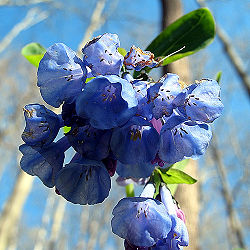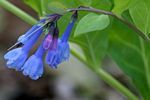Bluebells
| Bluebells | |
|---|---|

| |
| Scientific Classification | |
| |
| Species | |
| |
Bluebells are species of flowering plants belonging to the taxonomic genus Mertensia. [1] This bluebell is native to most States in North America. Their stems are hollow which make them very fragile. The bluebell, as its name states is bluebell and in the shape of bell hanging down from the branches of the plant. On very rare occasions, Bluebells will instead bloom into white or pink flowers.[2]
Anatomy
The Bluebell is a perennial dicot that is native to North America. It grows to 1 1/2 ft to 2 ft. It blooms between March and April and blooms into a blue color. The Bluebell does not produce fruit just its pretty blue petals. When the bud of the flower is pink before it blooms to blue. [3] These plants are usually found in dry areas in the woods. [4] There are 5 petals on the flower. The Bluebell prefers light shade for its habitat. The petals last until winter comes. In order to survive, the Bluebell needs 26 inches of water in a year to survive. [5] Bluebells have taproots and their ovaries contain 4 nutlet seed colonies. The leaves are 3-15 cm long and 1-5 cm wide and are veined. [6]
Reproduction
Bluebells reproduce sexually, containing male and female organs. Bluebells are Perennial plants which means that they last two or more years and flowers each year. [7]
Ecology
The bluebell creates food and energy by using photosynthesis. The bluebell stores energy that it doesn't use for energy during winter. Their bulbs are protected during the winter. [8] Bluebells are usually pollinated by honeybees, bumblebees, Anthophorid bees, Mason bees, large Leaf-Cutting bees, and Miner bees. Some other animals that depend on this flower are: hummingbirds, bee flies, butterflies, skippers, and Sphinx moths, including hummingbird moths.[9]
Uses
Certain breeds of the Mertensia are used for different purposes. The Mertensia paniculata (Tall Bluebell) was used medicinally in tea to treat the lungs and used as bandages for cuts. [10] The white bulbed versions was also used for glue and starch.
Gallery
References
- USDA
- Missouri Plants
- Mobot
- MSUE
- Easy Wild Flowers
- Montana Plant Life
- Zip Code Zoo
- Biotopics
- Illinois Wild Flowers
- Boreal Forest






